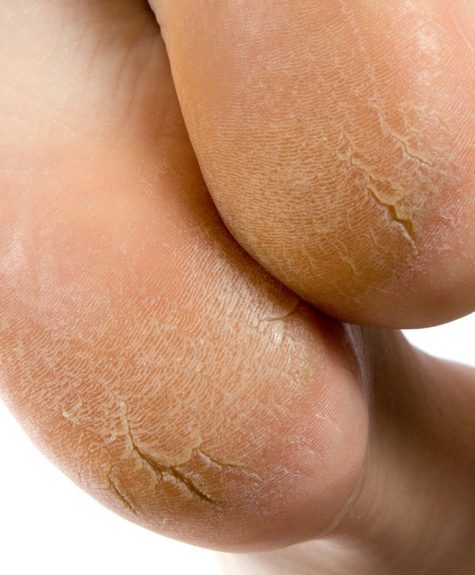What are Heel Fissures?
Heel fissures, also known as cracked heels can be a simple cosmetic problem and a nuisance. However, cracked skin on the heels can also lead to serious medical problems. Fissures on the feet occur when the skin on the bottom, the outer edge of the heel becomes hard, dry, and flaky, sometimes developing deep fissures that can be painful or bleed.
Cause
Heel fissures can affect anyone, but risk factors include:
- Living in a dry climate
- Obesity
- Consistently walking barefoot or wearing sandals or open-backed shoes
- Inactive Sweat Glands
- Athlete’s Foot (Fungal Infection)
Like many foot conditions, foot fissures can become more dangerous if they go untreated and become deep or infected. This is especially dangerous for people with diabetes or compromised immune systems.

What is Heel Fissures?
Heel fissures, also known as cracked heels can be a simple cosmetic problem and a nuisance, but can also lead to serious medical problems. Fissures on the feet occur when the skin on the bottom, the outer edge of the heel becomes hard, dry, and flaky, sometimes developing deep fissures that can be painful or bleed.
Cause
Heel fissures can affect anyone, but risk factors include:
- Living in a dry climate
- Obesity
- Consistently walking barefoot or wearing sandals or open-backed shoes
- Inactive Sweat Glands
- Athlete’s Foot (Fungal Infection)
Like many foot conditions, foot fissures can become more dangerous if they go untreated and become deep or infected. This is especially dangerous for people with diabetes or compromised immune systems.

Treatment and Prevention
Moisturizing the feet regularly can prevent heel fissures. Once they occur, you can use a pumice stone daily to gently decrease the thick and flaky layer of skin. Avoid going barefoot or wearing open-backed shoes, sandals, heel cups, or shoes with thin soles. Shoes with strong shock absorption can help to improve the medical condition by minimizing cracks or fissures on the fat pad.
Moisturizing the feet at least twice a day and wearing socks over a moisturizer or oil-based treatment like petroleum jelly while sleeping can also help while minimizing flaky and dead skin.
Your podiatric physician/surgeon from Southernmost Foot and Ankle Specialists has training specifically and extensively in the diagnosis and treatment of all manners of foot conditions. This training encompasses all of the intricately related systems and structures of the foot and lower leg including neurological, circulatory, skin, and the musculoskeletal system, which includes bones, joints, ligaments, tendons, muscles, and nerves.
Treatment and Prevention
Moisturizing the feet regularly can prevent heel fissures. Once they occur, you can use a pumice stone daily to gently decrease the thick and flaky layer of skin. Avoid going barefoot or wearing open-backed shoes, sandals, or shoes with thin soles. Shoes with strong shock absorption can help to improve the condition.
Moisturizing the feet at least twice a day and wearing socks over a moisturizer, antibiotic ointment, or oil-based treatment like petroleum jelly while sleeping can also help while minimizing flaky, dead, dry skin.
Your podiatric physician/surgeon from Southernmost Foot and Ankle Specialists has training specifically and extensively in the diagnosis and treatment of all manners of foot conditions. This training encompasses all of the intricately related systems and structures of the foot and lower leg including neurological, circulatory, skin, and the musculoskeletal system, which includes bones, joints, ligaments, tendons, muscles, and nerves.
